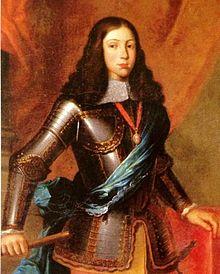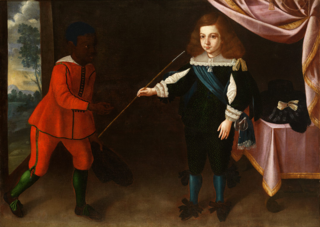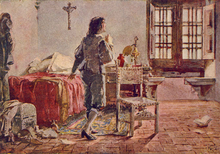| Afonso VI | |
|---|---|
 Portrait in the National Coach Museum Portrait in the National Coach Museum | |
| King of Portugal | |
| Reign | 6 November 1656 – 12 September 1683 |
| Acclamation | 15 November 1657 |
| Predecessor | John IV |
| Successor | Peter II |
| Regents | Luisa de Guzmán (1656–1662) Peter, Duke of Beja (1668–1683) |
| Chief minister | Count of Castelo Melhor (1662–1667) |
| Born | 21 August 1643 Ribeira Palace, Lisbon, Portugal |
| Died | 12 September 1683 (aged 40) Sintra Palace, Sintra, Portugal |
| Burial | Pantheon of the Braganzas |
| Spouse |
Maria Francisca of Savoy
(m. 1666; ann. 1668) |
| House | Braganza |
| Father | John IV of Portugal |
| Mother | Luisa de Guzmán |
| Religion | Roman Catholicism |
Dom Afonso VI (Portuguese pronunciation: [ɐˈfõsu]; 21 August 1643 – 12 September 1683), known as "the Victorious" (o Vitorioso), was the second king of Portugal of the House of Braganza from 1656 until his death. He was initially under the regency of his mother, Luisa de Guzmán, until 1662, when he removed her to a convent and took power with the help of his favourite, D. Luís de Vasconcelos e Sousa, 3rd Count of Castelo Melhor.
Afonso's reign saw the end of the Restoration War (1640–68) and Spain's recognition of Portugal's independence. He also negotiated a French alliance through his marriage. In 1668, his brother Pedro II conspired to have him declared incapable of ruling, and took supreme de facto power as regent, although nominally Afonso was still sovereign. Queen Maria Francisca, Afonso's wife, received an annulment and subsequently married Pedro. Afonso spent the rest of his life and reign practically a prisoner.
Early life
Afonso was the second of three sons born to King John IV and Queen Luisa. At the age of three, he experienced an illness that resulted in paralysis on the right side of his body. The condition was believed to have also affected his intellectual abilities. His father created him 10th Duke of Braganza.
After the death of his eldest brother Teodósio, Prince of Brazil in 1653, Afonso became the heir apparent to the throne of the kingdom. He also received the crown-princely title 2nd Prince of Brazil.
Reign

He succeeded his father, John IV, in 1656 at the age of thirteen. His mother, Luisa de Guzmán, was named regent in his father's will.
Luisa's regency continued even after Afonso came of age because he was considered mentally unfit for governing. In addition to lacking intellect, the king exhibited wild and disruptive behavior. In 1662, after Afonso terrorized Lisbon at night alongside his favorites, Luisa and her council responded by banishing some of the king's companions that were associated with the raids. Angered, Afonso took power with the help of Castelo Melhor and Luisa's regency came to an end. She subsequently retired to a convent, where she died in 1666.
Afonso appointed Castelo Melhor as his private secretary (escrivão da puridade). He proved to be a competent minister. His astute military organization and sensible general appointments resulted in decisive military victories over the Spanish at Elvas (14 January 1659), Ameixial (8 June 1663) and Montes Claros (17 June 1665), culminating in the final Spanish recognition of sovereignty of Portugal's new ruling dynasty, the House of Braganza, on 13 February 1668 in the Treaty of Lisbon.
Colonial affairs
Colonial affairs saw the Dutch conquest of Jaffna, Portugal's last colony in Portuguese Ceylon (1658), and the cession of Bombay and Tangier to England (23 June 1661) as dowry for Afonso's sister, Infanta Catherine of Braganza, who had married King Charles II of England.
Marriage
Melhor successfully arranged for Afonso to marry Maria Francisca of Savoy, a relative of the Duke of Savoy, in 1666, but the marriage was short-lived. Maria Francisca filed for an annulment in 1667 based on the impotence of the king. The church granted her the annulment, and she married Afonso's brother, Peter II, Duke of Beja.
Downfall

Also in 1667, Pedro managed to gain enough support to force Afonso to relinquish control of the government to him, and he became prince regent in 1668. While Pedro never formally usurped the throne, Afonso was king in name only for the rest of his life. For seven years after Peter's coup, Afonso was kept on the island of Terceira in the Azores. His health broken by this captivity, he was eventually permitted to return to the Portuguese mainland, but he remained powerless and kept under guard. At Sintra he died in 1683.
The room where he was imprisoned is preserved at Sintra National Palace.
Ancestry
| Ancestors of Afonso VI of Portugal |
|---|
References
- McMurdo 1889, p. 407.
- McMurdo 1889, pp. 416–417.
- Ogg 1934, p. 334.
- Ogg 1934, p. 325.
- ^ Livermore 1969, p. 195.
- ^ Ames 2000, p. 35.
- Helpful up-to-date information is available in Martin Malcolm Elbl, Portuguese Studies Review 30 (1) (2022): 131-198. "Through 'Deplorable' Eyes: Barlow in Lisbon (1661) ~ Elite Theatrics, King Afonso VI of Portugal, Bullfights, and a Common English Seaman". Retrieved 30 April 2023.
{{cite web}}: CS1 maint: numeric names: authors list (link) - McMurdo 1889, p. 441.
- Ames 2000, p. 25.
- ^ Livermore 1969, p. 185.
- ^ McMurdo 1889, p. 408.
- Davidson (1908), p. 14.
- Genealogy of the Dukes of Braganza in Portuguese
- ^ "Luísa Gusmão", Dicionário [Dictionary] (in Portuguese), Arq net.
- Marques 1976, p. 331.
- McMurdo 1889, p. 447.
- McMurdo 1889, p. 414.
- ^ Livermore 1969, p. 189.
- ^ Marques 1976, p. 332.
- ^ Stephens 1891, p. 331.
- For overview, with bibliography, in English, see Ricardo Fernando Gomes Pinto e Chaves, Portuguese Studies Review 30 (1) (2022): 113-130. "When the Desire (and the Obligation) Refuses to Work. The Sexualisation of the Prince's Power in the Context of Consolidation of the Dynastic States of Modernity". Retrieved 30 April 2023.
{{cite web}}: CS1 maint: numeric names: authors list (link) - McMurdo 1889, p. 417.
- Ames 2000, p. 30.
- Livermore 1969, p. 190.
- McMurdo 1889, pp. 423–425.
- Ames 2000, p. 32.
- Livermore 1969, p. 187.
- Livermore 1969, p. 188.
- ^ Stephens 1891, p. 333.
- Ames 2000, p. 37.
- McMurdo 1889, p. 430.
- Ames 2000, p. 28.
- Ogg 1934, p. 185.
- Dyer 1877, p. 341.
- Stephens 1891, p. 332.
- ^ Livermore 1969, pp. 192.
- ^ Ames 2000, p. 34.
- ^ Dyer 1877, p. 342.
- Livermore 1969, pp. 194–196.
- Davidson (1908), p. 236.
- The proceedings which the annulment of Afonso's marriage involved formed the basis of João Mário Grilo's 1989 film, The King's Trial.
- ^ Dyer 1877, p. 343.
- Livermore 1969, pp. 196.
- Chisholm, Hugh, ed. (1911). "Alphonso s.v. Alphonso VI." . Encyclopædia Britannica. Vol. 1 (11th ed.). Cambridge University Press. p. 734.
- Stephens 1891, p. 334.
Sources
- Ames, Glenn Joseph (2000). Renascent Empire?: The House of Braganza and the Quest for Stability in Portuguese Monsoon Asia, ca. 1640-1683. Amsterdam: Amsterdam University Press. ISBN 9053563822.
- Davidson, Lillias Campbell (1908). Catherine of Bragança, infanta of Portugal, & queen-consort of England.
- Dyer, Thomas Henry (1877). Modern Europe Vol III.
- Livermore, H.V. (1969). A New History of Portugal. Cambridge University Press. ISBN 9780521095716.
- Marques, Antonio Henrique R. de Oliveira (1976). History of Portugal. ISBN 978-0-231-08353-9.
- McMurdo, Edward (1889). The history of Portugal, from the Commencement of the Monarchy to the Reign of Alfonso III. London: Sampson Low, Marston, Searle, & Rivington. Retrieved 25 October 2023.
- Stephens, H. Morse (1891). The Story of Portugal. New York: G. P. Putnam's Sons. Retrieved 25 October 2023.
- Ogg, David (1934). England in the Reign of Charles II. Oxford University Press.
| Afonso VI of Portugal House of BraganzaCadet branch of the House of AvizBorn: 21 August 1643 Died: 12 September 1683 | ||
| Regnal titles | ||
|---|---|---|
| Preceded byJohn IV | King of Portugal and the Algarves 1656–1683 |
Succeeded byPeter II |
| Monarchs of Portugal | ||
|---|---|---|
| House of Burgundy (1139–1383) |  | |
| House of Aviz (1385–1580) | ||
| House of Habsburg (1581–1640) | ||
| House of Braganza (1640–1910) | ||
| Debatable or disputed rulers are in italics. | ||
| Princes of Brazil | |
|---|---|
| Dukes of Braganza | ||
|---|---|---|
| Feudal Dukes |  | |
| Heir to the Throne | ||
| Claimant to the Throne | ||
| Infantes of Portugal | |
|---|---|
| The generations indicate descent from Afonso I, and continues through the House of Aviz, the House of Habsburg through Infanta Isabel, Holy Roman Empress and Queen of Spain, and the House of Braganza through Infanta Catarina, Duchess of Braganza. | |
| 1st generation | |
| 2nd generation | |
| 3rd generation | |
| 4th generation | |
| 5th generation | |
| 6th generation | |
| 7th generation | |
| 8th generation | |
| 9th generation | |
| 10th generation | |
| 11th generation | |
| 12th generation | |
| 13th generation | |
| 14th generation | |
| 15th generation | |
| 16th generation | |
| 17th generation | |
| 18th generation |
|
| 19th generation | |
| 20th generation | |
| 21st generation | |
| 22nd generation | |
| 23rd generation | |
| 24th generation | |
| * also an infante of Castile and León, Aragon, Sicily and Naples, § also an infante of Spain and an archduke of Austria, # also an infante of Spain, ‡ also an imperial prince of Brazil, ¶ also a prince of Saxe-Coburg and Gotha, Duke in Saxony, ◙ also a prince of Braganza, ¤ title removed in 1920 as their parents' marriage was deemed undynastic, ƒ claimant infante | |